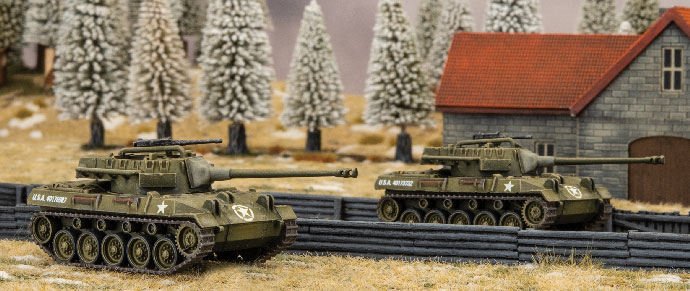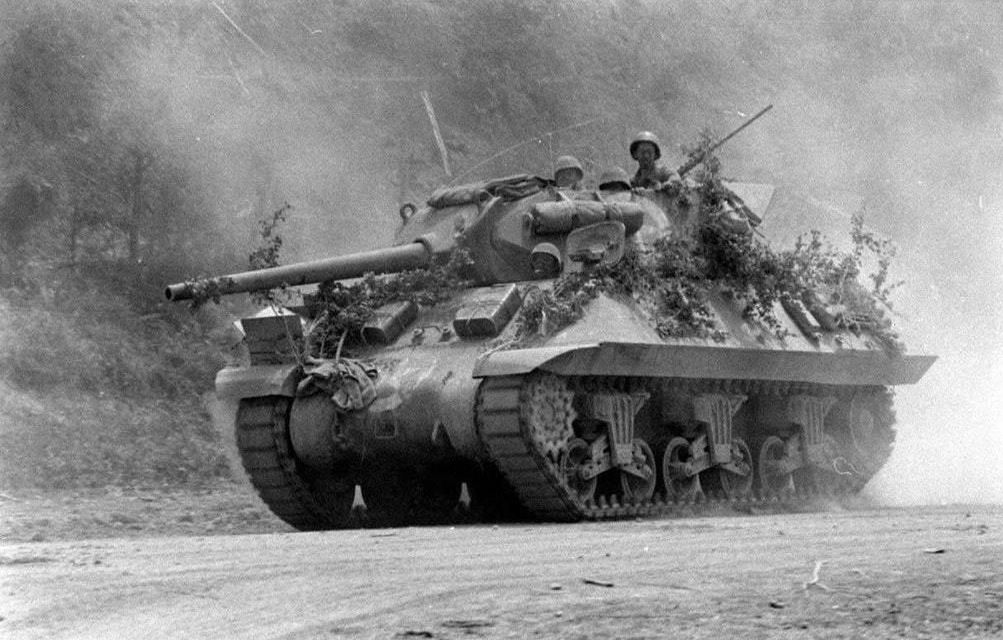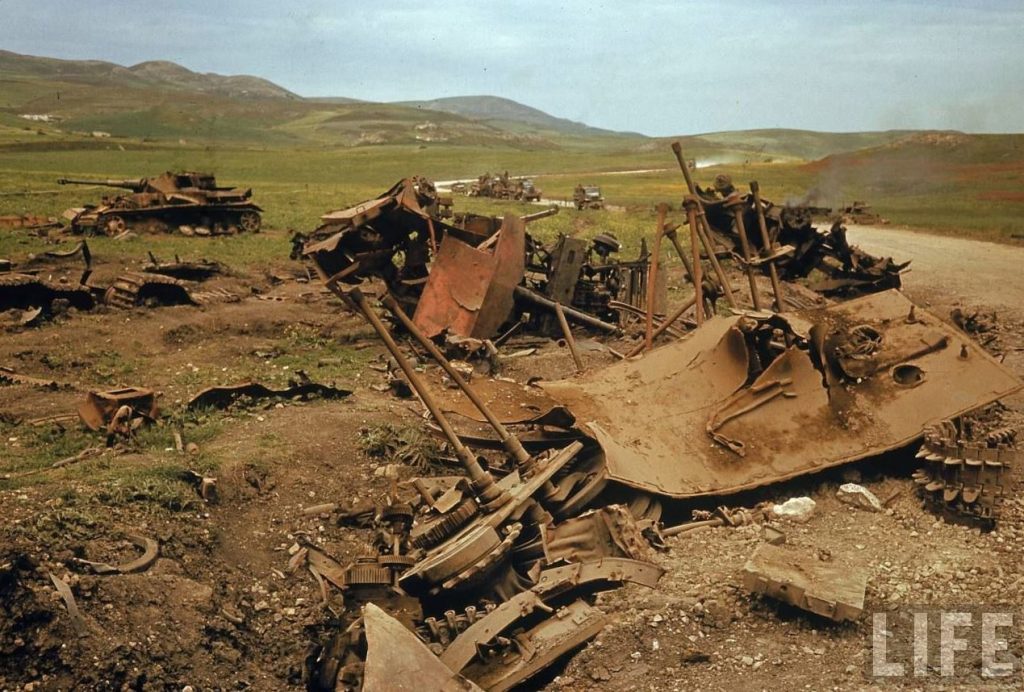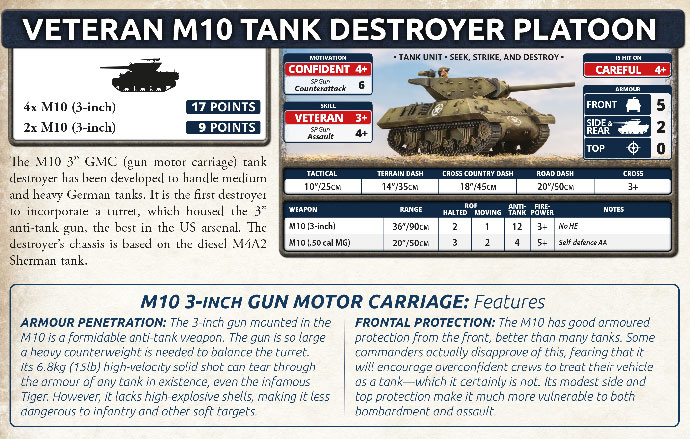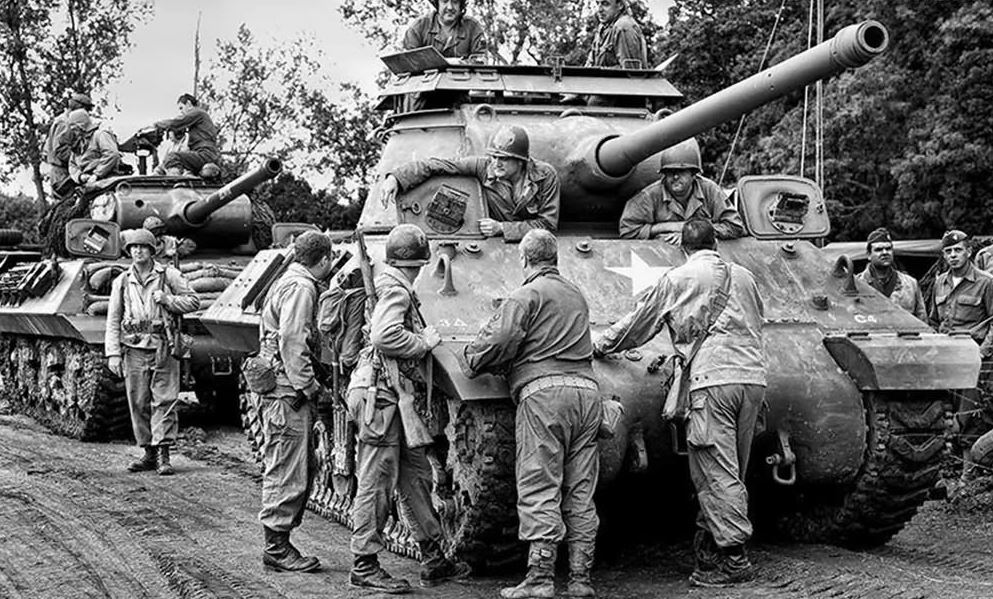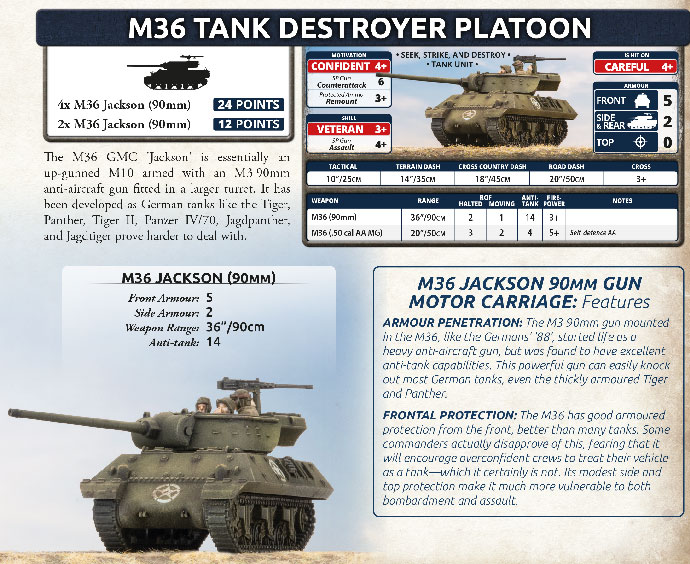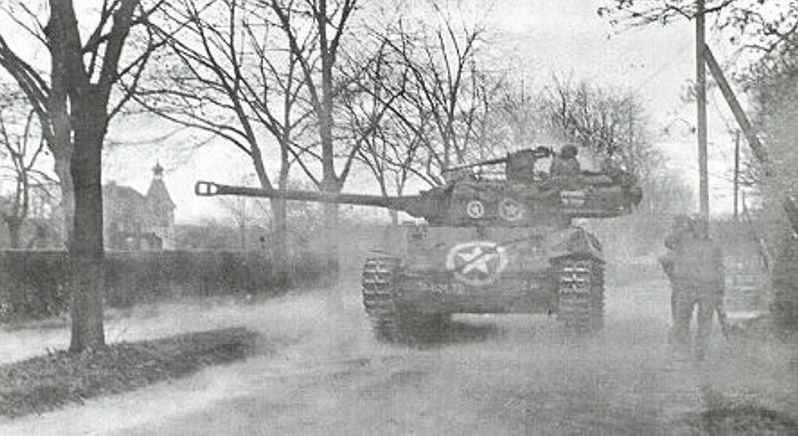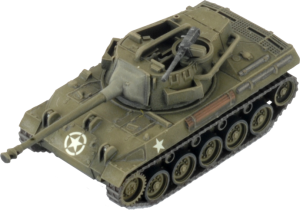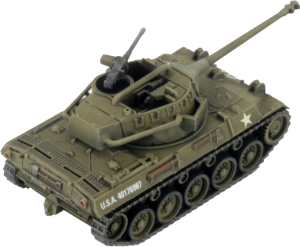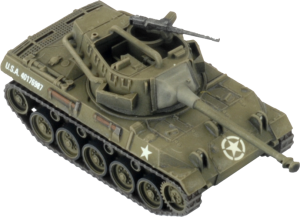With Adam Brooker
Bulge: American is a book a lot of people that play Late War US have been waiting for, especially those that used to enjoy Tank Destroyer Companies in the previous version. As before this all late war US Commanders had was the M10 ‘Wolverine’ which has been the TD work horse for Tank Destroyer Companies since Mid War. With the release of the Bulge: American book we see the addition of two more Tank Destroyers, the speedy M18 ‘Hellcat’, and the Big Cat Killer, M36 ‘Jackson’. The M18 Hellcat gives you a more manoeuvrable ‘glass cannon’ style of play, while the M36 Jackson is up-gunned to fight the larger German tanks, and can be beefed up to make it even harder to kill!
So you now have a few extra tools in your toolbox against the Big Cats, but they all work in different ways, let’s go through and see just how these tank hunters work, and their general strengths and weaknesses.
M10 Tank Destroyer
First up, the work horse, the M10 Tank Destroyer, as an aside, it is often given the nickname Wolverine now, especially in model kits, but there is no evidence it was ever called this during WW2. It was either called an M10 or just TD, it seems that model kit companies may have invented the nickname to help sales, as it was never officially given the designation Wolverine, like the M4 was given Sherman.
The M10 was an early design by the Bureau of Ordnance built around the US Tank Destroyer Doctrine, which was the mode of use that the US devised to defeat the German Blitzkrieg Doctrine or armoured spearhead doctrine. The US combined arms doctrine in WW2, was that tanks like the M4 Sherman would be used to support an assault on a defensive position by infantry and artillery and then they were to be used to exploit a breakthrough, and also to engage any enemy armour that they found during this assault. So really the M4 Sherman was only ever designed to support infantry, and was up-gunned almost under duress later in the war, as it was not originally intended to fight enemy armour, it was a support tank only according to their doctrine.
So what was to be used to fight a mass armoured breakthrough against your lines? A thin line of static anti-tank guns will not work if there is room to manoeuvre or enough mass, as the German Blitzkreig in France and Poland showed. The US came up with the Tank Destroyer Doctrine to combat this, the Tank Destroyers were designed to be a manoeuvrable version of the towed anti tank guns, to be held in reserve and then moved quickly to the area of the enemy breakthrough. They would then use speed, aggressive manoeuvring, and ambush tactics to defeat the enemy thrust.
It was to be purely defensive, they were not allowed to chase or charge at enemy tanks, they did not have the armour for it really anyway, and were to fight from defensive positions, and to withdraw using speed if they could not defeat the thrust, so as not to waste their vehicles and to set up another ambush in front of the enemy further down the line of their advance, direct contact in the open with enemy armour was to be avoided whenever possible. So this required a fast, well armed vehicle, with a turret to make aiming from a stationary position easier, which is what the 3” Gun Motor Carriage M10 was. It was also much cheaper to produce than a Panzer IV, Panther or Tiger, so had an economy of force there, compared to the cost of enemy losses.
It was first deployed in March 1943 in El Guettar in the North Africa Campaign, in the perfect scenario for the Tank Destroyer doctrine, it was going to blunt an armoured spearhead from a defensive position. 12 3” M10s and 31 75mm M3 half-tracks (an interim tank destroyer design), blunted the German attack, knocking out 52 of the 57 attacking German tanks including a Tiger. But this victory was not without cost, the US forces lost 5 of the 12 3” M10s, and 25 of the 75mm M3 half-tracks, which were heavy losses, but it did prove the worked in the minds of the US command, and the cost economically for the Germans, was much more than the cost of the half-tracks and M10s for the US.
The US losses in this battle seem to have been potentially higher because of the emphasis put on aggressive manoeuvring in the first TD manuals given to the TD crews, could be misinterpreted by crews. It seems that the crews were overly aggressive and put themselves into poor positions in an attempt to knock out the enemy armour, as they were charging at enemy tanks instead of staying in a better defensive position. So after this battle, in early 1944 the wording of the TD manuals was changed to put less emphasis on the aggressive verbiage, to prevent crews leaving excellent defensive positions for poor attacking positions in a TD not designed for that role.
It should be noted this battle was one of the few times the Tank Destroyer Battalions were used to defend against a German armoured thrust in the manner it was designed to meet them. It did work, and would have worked with much less losses, if you had more experienced crews and more M10s that were more suited to the role, instead of the interim M3 75mm half-track, but all in all a success for the doctrine.
It should be noted one of the deficiencies of the M10 was its slow turret traverse, which was unpowered, and the crew needed to hand crank it to traverse, which took 80 seconds to rotate a full 360°. This was rectified in both the M18 and M36 which had powered traverse systems installed in the turrets.
So in game the M10 has a reasonable front armour of 5, and a side and rear of 2, and open topped, so a top armour of 0. This FA 5 was good in mid war, where it had a decent chance of saving against shots frontally at range, but coming into late war, where anti-tank values are progressively getting higher, this is less competitive. It has the 3” M7 gun, with 36” range, an AT of 12, and 3+ firepower, with No HE. This is still a good gun for Panzer IVs, but anything larger/heavier than that it will struggle to penetrate unless it is in a flanking position, it also is not suited to blasting out anything with a infantry save due to the No HE rule.
It had a top speed of around 48 km/h on roads, which was fairly fast in 1943 when it was introduced, this translates to a 10” tactical move, a 14” terrain dash, 18” cross country dash, and a 20” road dash, with a 3+ cross check. This is a very manoeuvrable vehicle, that has a good chance of moving out of any difficult terrain that it may use as cover for an ambush, this is usually where this TD excels is late war, 8 shots of AT 12 in the side or rear if firing from ambush, then moving if needed.
The one difference from D-Day: American to Bulge: American is a slight cost increase of 1 point per 2 TDs, as they are now Veteran M10s, for which you gain Veteran (3+) skill. You still of course have the excellent Seek, Strike, and Destroy rule, that all TDs have – which allows you to attempt to make a Shoot and Scoot Movement Order after succeeding in a Blitz Movement Order earlier the same turn, both of which will now be easier to pass with your 3+ skill. This Blitz and Shoot and Scoot combination is a great trick to have up your sleeve, allowing you to sit behind a hill or other terrain, Blitz out, fire at full rate of fire, then move back with a Shoot and Scoot, both rely on your improved tactics 3+.
So overall it is still a capable TD, but it’s starting to get outclassed by its larger prey like the Panther, and even bigger prey like the Tiger, King Tiger, etc. Luckily the only formation you can take these in is the M36 Tank Destroyer Company, which has the up gunned M36 Jackson (90mm) which can more easily penetrate a Panther or Tiger frontally. So you can use the older M10 TD for lesser prey while the M36 deals with the bigger prey.
M36 Tank Destroyer
This TD also seems to have been given the unofficial nickname ‘Jackson’, similar to the M10 ‘Wolverine’, this does not seem to have been used officially during WW2, where it was just called an M36. It appears the model makers have struck again, but to be honest I like these nicknames, and often personally just call them Jacksons…
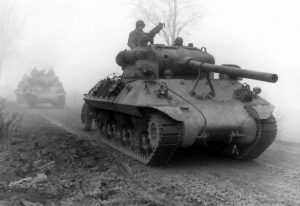
The M36 was essentially a M10 hull with a new turret on top that could mount and rotate a 90mm M3 anti-tank gun. It had a counter-weight at the rear of the turret and powered traverse to allow the large 90mm gun to be mounted, so the turret was slightly bigger and higher than the M10, it replaced. The older M10 was eventually being replaced with both M18s and M36s, so this allowed the assembly lines to quickly switch production.
It could penetrate a Panther or Tiger frontally from about 2000m, but it had to hit the vulnerable areas, so they generally had to get even closer to guarantee a one shot kill. Advancing troops into Germany liked this TD as they now had an effective weapon against German heavy tanks frontally rather than having to attempt to flank it, which usually led to the loss of advancing US tanks. But this success came at a cost, as it started to be used more as a tank, advancing to support infantry, rather than its stand-off, ambushing role.
Also as it was open topped it was vulnerable to supporting mortar and artillery fire as well as small arms assault by infantry, in fact the preferred German tactic for dealing with tank destroyers was artillery airburst overhead, which killed many crews. Some TD crews improvised canvas covers to stop hand grenades, while other made turret top armour from armoured sheets from captured vehicles, which did help and was standardised by 1945, but nothing but a fully armoured top would protect against the airburst artillery. They were also ambushed in turn by German anti-tank guns and assault gun, where they did not have the armour tanks led to high casualties, but the US Commanders often had no choice, they needed to knock out those German tanks, and the M36 was often the only tool they had.
In the tank battles of the Roer Plain in 1944, this was clearly evident, three companies of Shermans from the 67th Armored Regiment knocked out only 5 Panthers, while the M36s of the 702nd TD Battalion attached to it knocked out 15 Panthers as well as 8 Panzer IVs.
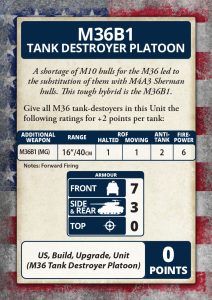

You can find the command card for the M36B1 in the Bulge American Command Card pack, which also has some other great upgrades for your force. I think this variant will be a great conversion project with the new plastic kits giving you all the parts you need to make this. I will be doing some up myself!
The M36 in game is essentially an upgraded M10, with all the unit statistics being the same, except for the new 90mm M3 main gun. It still has the same range as the smaller 3” gun on the M10, but with an increased AT 14 and does not have the No HE special rule, so no negative to hit infantry and gun teams.
You should be able to handle Panthers and Tigers with this TD although a Ferdinand/Elefant will still laugh at you and ask for more… There are rumours of even larger Wunderwaffe coming out the secret laboratory’s of Germany which your gun may not be able to penetrate… pray this is not true….
M18 Hellcat
The M18 Hellcat or 76mm Gun Motor Carriage M18 (M18 GMC) is the literal embodiment of the Tank Destroyer Doctrine. It was one of the fastest tracked vehicles of WW2 with a top speed of 89 km/h (55 mph) on road and 42 km/h (26 mph) off road, and the fastest US armoured fighting vehicle on road. Also given the kill to loss ratio of the Hellcat in WW2 it was the most successful US Tank Destroyer during the war, outscoring any other tank or tank destroyer.
The M18 Hellcat was all about speed, using speed as armour, using speed to get into position quickly to stop and enemy spearhead, and using speed to quickly flank an enemy tank that its gun could not defeat frontally. This was how the tank destroyer doctrine was envisioned, and why the M18 was designed as it was, and most of the crews loved it. The speed is what gave it the nickname Hellcat, being able to go up to 60 mph on roads, but was governed to 55 mph to prevent premature failure and wear.
To get this speed almost all armour was sacrificed, with only a maximum of 25mm of armour on the front of the turret, and the rest of the turret and hull having an average of 12mm thick plate. The Gun mantlet had an additional 19mm plate, but even this would not stop a Panzer IV AP round, let alone any of the larger German vehicles. This armour was just enough to stop any large calibre machine gun rounds, but nothing larger. But given Allied armour could not stop most German anti-tank weapons at this period of the war, this reduction of armour did not effect the average survivability of M18 crew.
Having an open top did give the crew excellent vision for spotting any enemy armour, but like the other open topped TD’s, it remained vulnerable to small arms fire, grenades, and as discussed before, the Germans favourite weapon against TD crews, airburst artillery.
Its 76mm M1A1 gun was the same gun seen on the up-gunned 76mm Shermans, which did give improved performance compared to the 75mm on a Sherman, but it still had trouble consistently penetrating a Panther or Tiger frontally, and usually when engaging one of these tanks, they would use their speed to quickly redeploy to the flank, where its gun could more easily penetrate its weaker side or rear armour.
The top speed of the Hellcat was rarely used in combat, but often a panzer commander was surprised by how quickly a Hellcat would turn up on their flank, when they expected it to still be engaging it from the front.
The M18 first saw action in Anzio (well the T70 prototype did), but most were in the European Theatre (19 M16 TD Battalions), with one M18 TD equipped Battalion in the Mediterranean Theater (805th), and some in the Pacific Theater later in the war, in Okinawa and the Philippines ( only the 637th saw combat). In general most of TD battalions that converted to the M18 from the M10 liked the vehicle, but one TD Battalion (835th) flat out refused to convert to the M18, and stayed using the M10. Their concerns seemed to be the lack of armour protection compared to the M10.
Against the Germans the M18 was very successful, in September 1944, around the Nancy bridgehead, the 704th TD Battalion in support of the 4th Armoured Division found the German 113th Panzer Brigade, in the early morning fog. A M18 Hellcat Platoon from C Company, came upon a German tank in the fog, they quickly knocked out 5 tanks for the loss of one M18. They continued firing and knocked out another 10 tanks ( some of which were Panthers) for the loss of two more M18s.
Another example is the fighting around the Battle of the Bulge in December 1944, defending Noville against a push by the veteran German 2nd Panzer Division, they used the top speed of their TDs to get in front of the enemy spearhead via roads and ambush them as they advanced. M18s of the 705th TD as well as Paratroopers from 1st Battalion, US 506th Parachute Infantry Regiment, knocked out 30 German tanks (including Tigers) as well as up to 1000 infantry casualties on the supporting German infantry.
This is another example of the Tank Destroyer Doctrine being used successfully to stop a German armoured thrust, which rarely happened in this period of WW2. But here it is thought the high speed allowed the M18s to quickly re-position and re-engage the enemy, which not only confuse them, but made the Germans think they were facing a much larger force than was actually present. This slowed and eventually stalled their thrust and allowed the US forces to hold the town overnight.
Overall only around 2500 of a planned 9000 M18s were supplied to the US Army, with no other ally being interested in using it. Although it was successful in what it was designed to do, it was more often being forced into a support role, rather than its intended task of stopping mass enemy armoured forces. This is simply because the Germans were now on the defensive, and it rarely had a chance to perform the task it was designed to do. As the war progressed deeper into the Germany, assaulting enemy positions, some of the M18 TD Battalions were converted into M36 TD Battalions, as the need to defeat larger tanks frontally increased.
In game terms, think of essentially the same gun of the M10, on a much faster, less armoured chassis. This TD screams fire and manoeuvre, with a tactical move of 12” and a blistering terrain dash of 18”, if used in space and in conjunction with some terrain, will be very good at flanking slower enemy vehicles. It still has the veteran skill, so can also use the Seek, Strike, and Destroy rule to pop in and out of terrain as well. But be very aware of your low armour, a FA of 2 and a Side Armour of 1 means you better hope your opponent fails his firepower save…… Even better is if you are not hit at all, so always try to fire from concealment to give you the best chance at surviving any return fire.
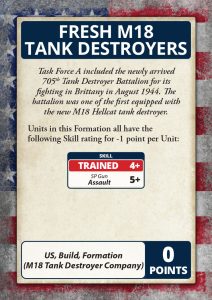
Another is the Sandbag Armour (which can be used on all tanks) to give you essentially improvised armour ( a 5+ save), against firepower 5+ and above shots, but it also reduces your dash speed, which may not be a good idea on an M18, but could be useful on a M36 or M36B1??
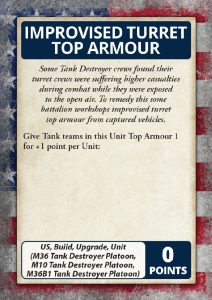
The final gem from the Command Card deck is the Tank Destroyer Hyper-Velocity AP card, I’m pretty sure all my TD’s that can will be taking this…. I feel it is a must have for the M18s, but the M10s have the M36 to take care of the bigger kitties.
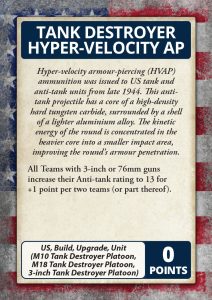
For +1 point, per 2 teams (or part thereof), you gain AT13, this can be applied to all M10 and M18 Platoons, this can make it that little bit easier to penetrate a Panther or Tiger frontally, which in some situations you don’t have a choice but to do that. So go nuts… I will, your unit must have found a secret stash like mine did!!!
I hope this gives you a good idea of the different TD units in the Bulge American book, as well as the Command Cards that allow you lots of interesting upgrades. For me personally I am really looking forward to the M18 Company, but the M36 Company, with the mix of M10 and M36s allows a good mix and the command cards allow even more variation.
Just remember to use you Blitz and Shoot and Scoot roll when you can, you are paying for those skills and rules, so make use of them!

